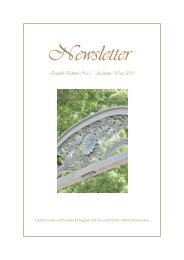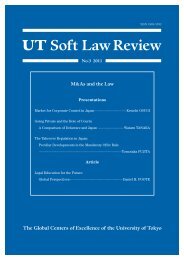UT Soft Law Review
UT Soft Law Review
UT Soft Law Review
Create successful ePaper yourself
Turn your PDF publications into a flip-book with our unique Google optimized e-Paper software.
<strong>UT</strong> <strong>Soft</strong> <strong>Law</strong> <strong>Review</strong> No.2 2010economic transition] that the U.S. experienced in the 1980s and early 1990s.” 8The key point is that in the United States, the overriding focus of the entire corporatesystem on shareholder wealth maximization (the property model of the firm), the relativelyrobust nature of complementary market institutions, and the decentralized, formalistic andaggressive enforcement environment in the United States 9 all work together to constrain thedegree to which managers can use the agency slack created by the poison pill to theirbenefit. 10Perhaps a foreign system always appears more complicated to a distant observer, but myprincipal impression of the Japanese institutional setup for takeovers so far is its multi-layeredand complex nature. Courts have the ultimate authority on takeover-related disputes, but thejudicial decisions are influenced by the METI/MOJ Takeover Guidelines. Indeed, theGuidelines were drafted specifically to lend guidance to courts and market participants. TheGuidelines contain both standards (defensive measures should be “necessary and proper”)and rules (“details of defensive measures must be disclosed in advance). The Guidelines werepromulgated by two ministries (only one of which has unambiguous jurisdiction over theCompany <strong>Law</strong>), but the policy of the ministries, in turn, was heavily influenced by thethorough work of the Corporate Value Study Group. The Corporate Value Study Group isitself a mixed body of experts, containing representatives of both corporate managers andinvestors. The Corporate Value Study Group continues to be influential. It provided adetailed supplemental commentary on takeover defense policy in the wake of the highlycontroversial Bull-Dog Sauce ruling, which correctly or not was interpreted by the foreigninvestor community as another sign that Japan is closed to foreign investment and out of stepwith global corporate governance standards. After the Guidelines were promulgated,revisions to Japan’s securities laws added a partial mandatory bid rule. Until then, we did notsee a shareholder rights plan and a mandatory bid rule in the same jurisdiction.But the complexity (some might say ambiguity) of Japan’s current takeover policy is notsurprising. Japan is undergoing dramatic economic, social and legal changes. Major questionsare under debate: Should Japanese firms be more “American” (market oriented)? 11 Shouldthe Japanese legal system be more transparent and participatory (court centered)? What8 Ronald J. Gilson, The Poison Pill in Japan: The Missing Infrastructure, 2004 Colum. Bus. L. Rev. 21, 39(2004).9 On the different types of enforcement culture around the world, see Curtis J. Milhaupt and Katharina Pistor,<strong>Law</strong> and Capitalism (University of Chicago Press, 2008).10 To be sure, the entire market system of the United States is under reconsideration following the subprimelending and financial crises. It is too early to say whether the market-oriented U.S. corporate governancesystem will be materially altered by the crisis.11 As an example of the disagreement about this question, compare the remarks of famous JapanologistRonald Dore (“After less than two decades of missionary activity, the conversion of Japan to the theologyof shareholder sovereignty seems complete,”) Japan’s Conversion to Investor Capitalism (working paper))with those of former METI Vice-Minister Takao Kitabata (“Excellent American companies are differentfrom what are called ‘American-style’ in Japan. Rather, I have discovered that they are similar to Japaneseenterprises.” ). Kaisha wa, kabunushi no mono dake ka?.32





